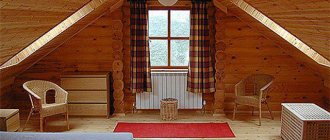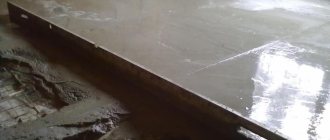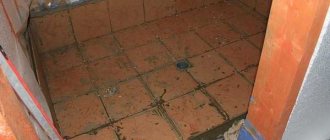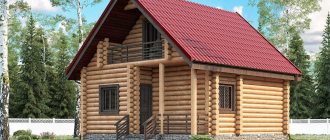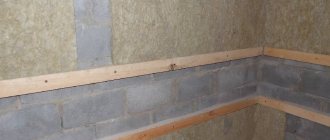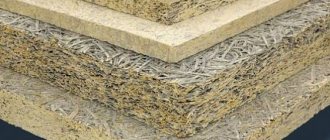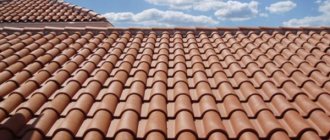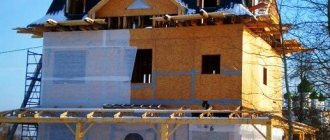Recently, people have been trying to pay more and more attention not only to the cost of housing and the comfort in it, but also to how environmentally friendly the materials from which it is built are. It is calculated in advance what to use for the foundation, walls, and roof. There are more and more people wanting to build modern, high-quality houses made from natural materials for year-round living.
Wooden floor plan.
The best option for the ceiling in such a house would, of course, be well-dried wood.
If you prefer environmental friendliness, you should choose natural materials for thermal insulation of ceilings in a wooden building, such as sawdust, shavings, etc.
Summary comparative table of insulation for the home
Organic and inorganic insulation for ceilings are discussed above. It is difficult to isolate the main thing from the mass of information. Therefore, for clarity, we summarize the main technical characteristics of heat insulators in Table 2.
Table 2. Main indicators of insulation for the ceiling.
| Characteristics / Insulation | Thermal conductivity, W/(m×°K) | Service life, years | Density, kg/m3 | Price |
| Hard polyurethane foam | 0,024-0,035 | 30 | 20-80 | ***** |
| PPU slabs | 0,028-0,030 | 50-60 | 40-160 | **** |
| Styrofoam | 0,037-0,043 | 5-7 | 8-35 | ** |
| Extruded polystyrene foam | 0,028-0,034 | More than 50 | 28-45 | ***** |
| Foamed polyethylene | 0,037-0,051 | Over 30 | 26-74 | *** (****) |
| Expanded clay | 0,10-0,18 | 40-60 | 210-500 | *** |
| Ecowool | 0,032-0,041 | More than 50 | 30-75 | ** |
| Linen mats | 0,034-0,043 | 50-75 | 25-50 | ***** |
| Cork | 0,039-0,50 | 30-50 | 100-250 | ***** |
| Sawdust | 0,07-0,10 | More than 100 | 200-270 | ** (*) |
| Basalt wool | 0,038-0,047 | More than 50 | 30-300 | *** |
| Glass wool | 0,035-0,052 | 15-25 | 15-150 | *** |
| Wood fiber mats | 0,039-0,052 | More than 50 | 150-230 | ***** |
- ***** - high;
- **** - above average;
- *** - average;
- ** - low;
- * - for free.
Analyzing the table, we will draw several conclusions on the topic of how best to insulate the ceiling of a private house.
- The use of expensive materials: rigid polyurethane foam, extruded polystyrene foam, linen and wood-fiber mats, cork can be afforded by wealthy homeowners. At the same time, cheaper materials will cope with the task no worse.
- It is advisable to avoid expanded clay. There are two reasons: the high cost of insulation and the large weight load on the ceiling - about 200 kg/m2 or more than 7 tons per room of 36 m2 (standard for a wooden house). The low price of 1 m3 of material compared to other types of insulation should not be misleading - the large thickness of the thermal insulation layer not only eats up the difference in price per m3, but also leads to an increase in the cost of work by an average of 1.5 times.
- Rigid polyurethane foam, glass wool and polystyrene are not suitable due to their short service life.
- It seems ideal to insulate the ceiling in a ventilated attic with sawdust with a layer thickness of 35-40 cm: the cheapest, yet durable option, with excellent thermal insulation properties.
- The next in the ranking are: basalt wool and polyurethane foam slabs. Moreover, they are higher in the rating when insulated from the inside.
- Insulation of suspended and suspended ceilings from the inside can be done with foil-clad polyethylene (foam). It cannot be used for pasting and painting for several reasons: it is difficult to attach with glue - it simply does not stick; any touch to the paint or wallpaper will leave a dent - there is no rigidity (easily deformed without restoring its shape).
In an effort to save on heating during the cold season, home owners resort to improving their buildings: studies show that a significant part of the heat received from the heating system simply goes outside due to poor thermal insulation of the structure. The culprits of such losses are not only walls, but also uninsulated foundations, floors, ceilings and roofs, and an uninsulated roof leads to considerable losses; about a third of the thermal energy can escape through it from the house. So those homeowners who do not want to heat the streets in winter at their own expense have to think about insulating the roof of a wooden, brick or frame house.
Content
- Criteria for choosing insulation video
- Types of insulation materials that are actively used for roof insulation in modern construction
- Thermal insulators of inorganic origin
- mineral wool video
- Styrofoam
- extruded polystyrene foam
- Thermal insulators of organic origin
- cork insulation
- ecowool
- straw video
- hemp
- seaweed
- Some useful tips from experts
Criteria for choosing insulation
Insulating the roof of a house with your own hands is a very important and responsible step; the insulation process is not as simple an undertaking as it might seem at first glance. It will require the correct selection of insulation materials, and therefore knowledge of their technical characteristics and installation features, correct calculation of the thickness of the insulating layer depending on the material and configuration of the roof.
First, let's decide on what criteria should be used to make a choice.
First of all, let's pay attention to the thermal conductivity indicator. It is measured in W/(m-K), it shows how much heat passes per unit time through a unit area of the test material of a given thickness. The thermal conductivity of different samples can differ significantly. That is why it is important to pay attention to insulation with a low thermal conductivity coefficient; porous, lightweight materials usually have it. The ideal for insulating the roof of a house is considered to be one whose coefficient tends to 0.025 W/(m-S).
When choosing insulation among materials with equal coefficients, preference should be given to the one that has a higher compressive strength and resistance to external loads. Of no small importance for high-quality insulation is the moisture resistance of the insulation. Ideally, the water absorption rate should approach 0. Materials that meet such requirements have a solid, uniform structure. You can find out about the water-absorbing properties in the technical specifications that are posted on the manufacturers’ websites.
Unfortunately, some insulation materials that fully comply with the previous requirements do not meet fire safety requirements.
- The flammability marking indicated on them indicates the degree of flammability, with the G1 indicator indicating that the material is slightly flammable, G2 and G3 moderately flammable, G4 indicating that it is fire hazardous. You should not take risks; it is better not to use materials marked G3 and 4 for roof insulation.
- Insulation materials marked D1 are characterized by low smoke-generating ability, D2 - moderate, D3 - high; with this indicator, the combustion process will be accompanied by the release of a large amount of smoke with impurities harmful to humans.
- The ability to spread flame over the surface is also indicated in the marking, the minimum indicator is PR1. the maximum is PR4, which designates materials that strongly spread flame. In appearance, a high-quality insulator should be uniform and even.
The required thickness is calculated in accordance with the SNiP rules on thermal protection of buildings. When calculating, you will need to use the coefficient for a specific geographic area. We pay attention to the service life - it should be long, the quality characteristics should not change during the period of operation.
The insulation should not have a lot of weight, since weighting the roof can negatively affect its supporting structures, as well as other structures of the building. We draw attention to the environmental friendliness of the heat insulator:
- it must not pose a danger to humans or the environment,
- do not contain harmful chemical impurities, for example, formaldehyde,
- freon should not be used in its production,
- it should not contain very fine particles or dust.
The belief that insulation materials made from natural materials are more environmentally friendly is not entirely true; for example, in the manufacture of mineral wool, formaldehyde resins are used, and the structure of the material allows them to be released when the ambient temperature rises.
It will not be enough to be guided solely by technical parameters when choosing a heat insulator; you must take into account the location of the construction.
Types of insulation materials that are actively used for roof insulation in modern construction
Firstly, it should be noted that all insulation materials can be divided into those made from inorganic raw materials and those based on organic components. Now let’s take a closer look at the main advantages and disadvantages of the most popular types of thermal insulation.
Thermal insulators of inorganic origin
mineral wool
Thermal insulator, characterized by good heat retention, low fire hazard, good sound insulation, vapor permeability, is available in the form of plates or rolls, can have a density from 20 to 200 kg/m3, this variety allows you to choose the type that is needed in a particular situation. Mineral wool insulation is an ideal option for wooden structures - it provides good thermal insulation and does not deprive the wood of its natural ability to “breathe”.
Disadvantages include the ability to absorb moisture, which leads to a sharp loss of heat-saving characteristics, the inability to use unprotected roofs or facades for insulation, and the inability to completely dry the material if moisture gets inside it.
Styrofoam
It attracts with a very high rate of heat conservation, it can have different densities, it practically does not absorb moisture, it is available in the form of slabs of different sizes, it is light in weight, it is very easy to cut, and its installation is quick.
Negative aspects: tendency to flammability and formation of toxic smoke during combustion, reacts to exposure to direct ultraviolet rays, the structure of the heat insulator causes its fragility, therefore, care is required during transportation and installation. Insulating the roof and walls with polystyrene foam will require the installation of a supply and exhaust ventilation system in the house - the material does not “breathe”.
extruded polystyrene foam
It is a type of polystyrene foam, but consists of closed polystyrene cells. It is distinguished by its inability to absorb moisture, durability, and excellent heat-saving characteristics. But extruded polystyrene foam also does not “breathe”, it is prone to fire and releases toxic substances during combustion.
Owners who want to live in more comfortable and safe conditions can resort to insulating the roof from the inside using materials made from organic raw materials.
Thermal insulators of organic origin
natural cork insulation
They are made from chips of solid oak bark, or recycled, by processing with hot steam under high pressure and pressing, the binding component is natural resins. Such a heat insulator is capable of good air permeability, its surface does not contribute to the development of mold and fungi. The material is flammable, but does not emit toxic substances when burned. It is suitable for insulating the roof of a house, its walls, ceilings, and floors.
ecowool
It is made from waste paper; synthetic materials are not used as binders in its production; the only impurities in ecowool are fire retardants, the purpose of which is to reduce the level of fire hazard. Ecowool allows air to pass through well, but it is also prone to moisture absorption. When installing such insulation, a layer of waterproofing must be provided. Ecowool is sensitive to mechanical loads; the best option for its use would be to insulate attics. There are also rigid cellulose insulation materials, but binders are used in their manufacture.
straw
Some may be somewhat surprised by the fact that such exotic materials as straw are used nowadays. However, straw has been used very successfully as a roofing material for many centuries. The thatched houses were surprisingly cool in summer and warm in winter. Today, straw insulation is produced industrially, by pressing straw from barley, rye, oats, and wheat, with further binding of the resulting blocks with mesh or wire. Straw is a highly breathable material; to improve its fire-fighting properties, fire retardants are used.
hemp
Such insulating material as hemp has not been forgotten today either. It serves as a raw material for the production of natural-based thermal insulation materials. Such products are produced in the form of slabs, rolls, mats or individual fibers with which to caulk cracks. To reduce the material's susceptibility to fire, it is treated with boron salts. The material is not afraid of mold and fungi, it allows air to pass through, but pressure loads have a detrimental effect on it.
seaweed
The roof of a house can also be insulated with algae. Before they are used, the seaweed is dried and made into bulk materials or pressed into slabs. Since they are impregnated with salt, they are not afraid of mold, they do not burn or rot. The beams located under the algae ladders are always dry, this significantly extends their service life.
Some useful tips from experts
Even though some insulation materials may not seem so cheap, experts recommend not saving on purchasing high-quality and environmentally friendly material, because only in this way can the goal of a comfortable atmosphere and temperature in the house, and the health of all household members, be achieved. Properly selected materials for roof insulation will help extend the service life of all structural elements of the house.
Even the highest quality insulation may not be effective if it is installed poorly. Therefore, it is best to trust people with relevant experience to carry out roof insulation work. In addition, installation work may differ slightly depending on the material from which the house is made; for example, the insulation of the roof of a frame house and a wooden or brick one may have some differences.
When choosing insulation with the optimal ratio of cost and quality, remember that you and the people closest to you will live in the house where it will be used.
Author: Sergey and Svetlana Khudentsov
0
What is the best way to insulate the ceiling in different rooms?
The type and type of room impose their own characteristics on the choice of insulation for different buildings. Therefore, we will consider how to correctly choose thermal insulation materials for an apartment, bathhouse, garage and cottage.
Apartment. When insulating the ceiling in an apartment, you need to take into account that it is carried out only from the inside, stealing the useful volume. Therefore, the thickness of the insulating layer comes to the fore. The leaders here are PPU slabs, cork (though very expensive), polystyrene foam and extruded polystyrene foam. If the ceiling height is more than 2.5 m, basalt slabs seem to be optimal in terms of price/quality combination.
Bathhouse. In the old days, they didn’t think about how to insulate the ceiling in a bathhouse - they laid roofing felt on the attic side (it holds steam) and covered it with a half-meter layer of sawdust.
Attention: they have stopped producing roofing felt. Therefore, modern lovers of steam baths have replaced it with parchment paper or oiled newspapers.
With the advent of new types of insulation, they began to experiment. As a result, we came to the conclusion that it is best to steam in a bathhouse with the ceiling insulated with foil heat insulators. But here it’s not for everyone. The steam in such a steam room is harsher. Those who have steamed in old bathhouses in villages will understand what we are talking about: at the same steam temperature, a hat and mittens are not needed.
Garage. The garage ceiling can be insulated from the outside and inside. Externally, expanded clay is mainly used. Rarely basalt wool. Sometimes foam. From the inside, the ceiling space is insulated with glass wool, followed by lining with clapboard or moisture-resistant plasterboard, polystyrene foam or basalt wool for painting. It is not practical to use other materials for financial reasons.
Country house. Dachas made of aerated concrete are insulated with everything that comes to hand.
This could be moss from a nearby swamp (by the way, it retains heat very well), dry leaves, reed mats, sawdust. Wealthier owners can afford glass wool and polystyrene foam. Many country houses with brick walls are insulated with expanded clay. But the editors of the StroyGuru.Com website do not recommend this option for ceiling insulation. The reasons are stated just above.
Do-it-yourself insulation of the ceiling of a bathhouse without an attic: nuances of work
The technology for insulating a wooden or panel bath, in the case of a complete absence of an attic space, has some differences from those discussed earlier. In this case, it is necessary to secure the vapor barrier material, and then attach the insulation itself. The beam beam and the final layer - ceiling boards - are already attached to it.
Particular attention should be paid to the junction of the insulation and the pipe. First of all, this is necessary to ensure compliance with fire safety standards. The indentation provided for by the rules must be at least 200 mm. Naturally, you can’t just leave a hole, and therefore a simple box consisting of rafter legs is mounted. Its main role is the separation of insulation and pipes.
Helpful advice! The inside of the box can also be filled with thermal insulation material. True, it must be fire-resistant and not susceptible to high temperatures. For example, stone wool is suitable for this.
Before laying layers of insulation and insulation, it is recommended to treat the wooden ceiling with special means to eliminate the possibility of the development of harmful bacteria and fungi
Another important task that faces the owner who is insulating the ceiling of a bathhouse without an attic is to completely eliminate the risk of condensation. Therefore, all vapor and waterproofing materials must be of high quality and attached in strict accordance with the rules and regulations.
Installation technology
Ceiling insulation can be carried out from the inside and outside.
From the inside
Insulation from the inside can be done using two technologies:
- with lathing;
- without sheathing.
With lathing. A coniferous beam or a metal profile is attached to the ceiling, regardless of whether it is wooden or reinforced concrete. Insulation is installed between the cells. A vapor barrier film (type B) is stretched over the heat-insulating layer. A counter-lattice is placed under the sheathing. The process ends with fastening the sheathing.
If a suspended or suspended ceiling is planned, then vapor barrier is the last stage of insulation work.
Without sheathing. The option of attaching insulating mats and slabs without lathing is used when painting the ceiling or gluing wallpaper. In this case, the insulation is first glued to the ceiling with glue, then additionally fixed with special dowels with a large head or a special washer.
The process is completed by gluing the reinforcing mesh and puttying the surface of the insulated ceiling. The operations are described in detail in the works: “Insulation of the ceiling with mineral wool” and “Insulation of the ceiling with polystyrene foam”.
Outside
When insulating the ceiling from the outside according to SNiP, all operations are performed in the following sequence:
- roofing material or polyethylene film is laid on the ceiling for vapor barrier. In this case, it will be correct to place the rolled materials on the beams (beams) and on the walls;
- fill or lay insulation material;
- cover the insulation with a vapor barrier membrane (type A or AM);
- lay a flooring over the beams or insulation for walking in the attic space.
You can learn more about the technology in the work “Ceiling insulation with expanded clay.”
Features of the arrangement of vapor barrier and waterproofing layers
The presence of a vapor barrier layer is not a whim, but a real necessity. Especially when it comes to rooms such as a bathhouse, where hot air is an integral part of using the room for its intended purpose. Rising in the form of steam, moisture can have a destructive effect on the insulation and contribute to the formation of mold and mildew on the wooden elements of the bathhouse frame.
Scheme of insulation and insulation of a bathhouse roof
In order to avoid problems that may arise as a result of moisture accumulation on the ceiling and walls, special films and coating materials are used, for example, anti-condensation membranes. When choosing a suitable material, it is advisable to purchase one that has a foil layer.
Helpful advice! During the installation of a vapor barrier film, it is very important to pay attention to its integrity. It is necessary to prevent the occurrence of gaps, as this will greatly affect the technical characteristics of the coating.
To ensure waterproofing, special films are used, which can be purchased at hardware stores. Sometimes the most ordinary polyethylene of sufficient density or cheap roofing felt is used.
To protect the bath frame from moisture, it is recommended to use a waterproofing membrane, which can be mounted in contact with the insulation without losing its properties
Conclusion
Ceiling insulation is a necessary step in home insulation. Currently, this procedure can be performed in various ways and materials. You should choose based on the type of ceiling, type of housing (house or apartment), method of finishing the ceiling and some other factors.
See the video in this article for more information. If you have any questions regarding ceiling insulation, ask them in the comments and I will be happy to answer you.
Did you like the article? Subscribe to our Yandex.Zen channel
Expert advice
We went through popular YouTube channels, where they talk about baths authoritatively, knowledgeably, by people whose opinions we ourselves listen to. But the only problem is that they talk about a lot of things, but for some reason the problem of insulating ceilings, as well as the choice of materials, does not attract everyone’s attention.
Therefore, don’t blame me, the example of expert advice on ceiling insulation will be the video below, made - we simply couldn’t find anything more significant.
But what’s interesting is that you won’t hear standard descriptions in it. On the contrary, the authors of the video turn to the experience of previous generations and offer the most budget-friendly, simplest option for organizing both the ceiling itself and its insulation - this is a completely simple floor ceiling, insulated... with sawdust and clay. It couldn't be simpler.
You don’t even need to bother with the lining - you can make the flooring boards into a finished ceiling if you plan and sand them first.
Of course, any opinion will be controversial, and you have the right to question it or not consider it an expert.
***
Now that it is already clear why a ceiling without insulation is a waste of heat, all that remains is to wish every owner that in any weather his bathhouse will warm up properly and keep warm for the second day.
